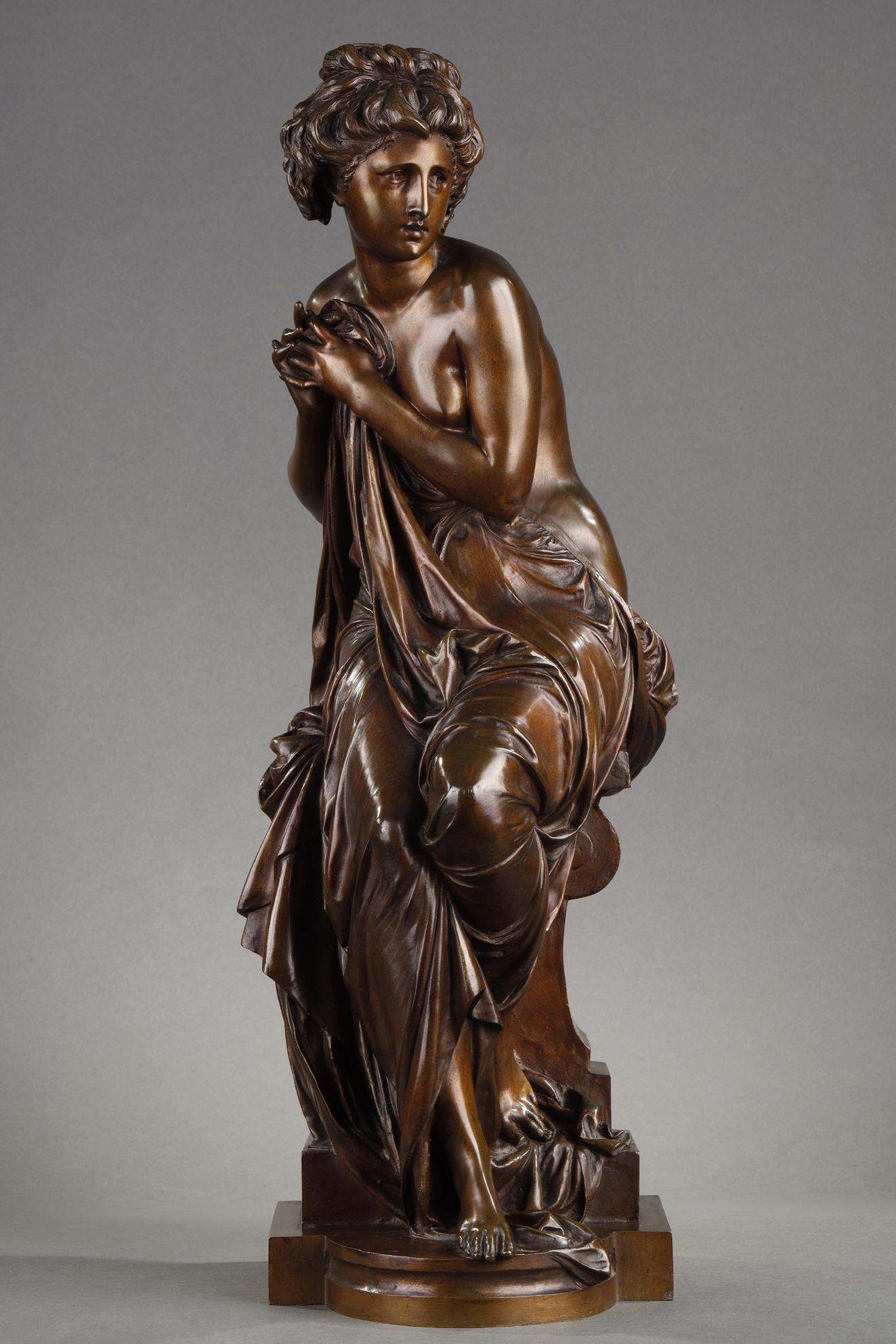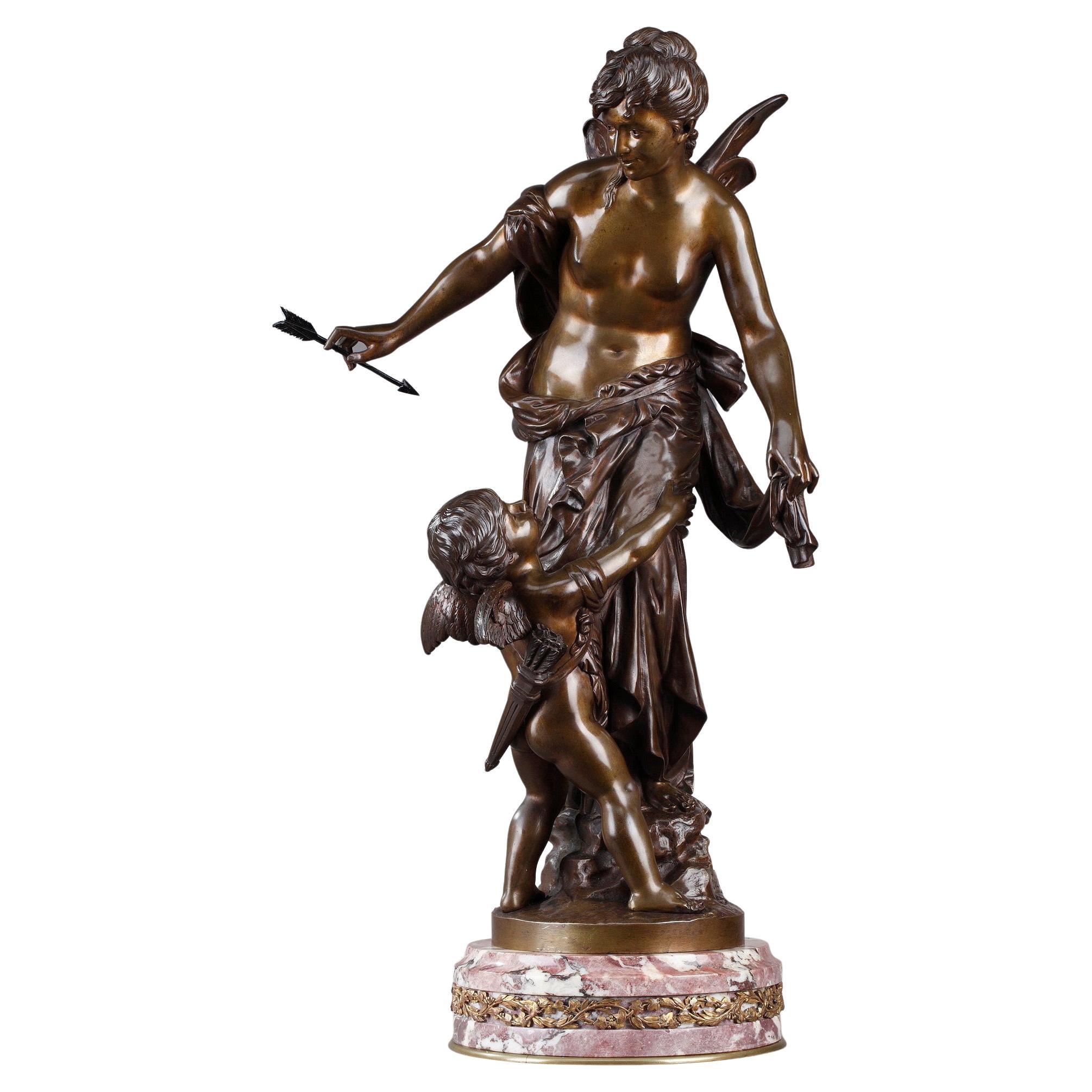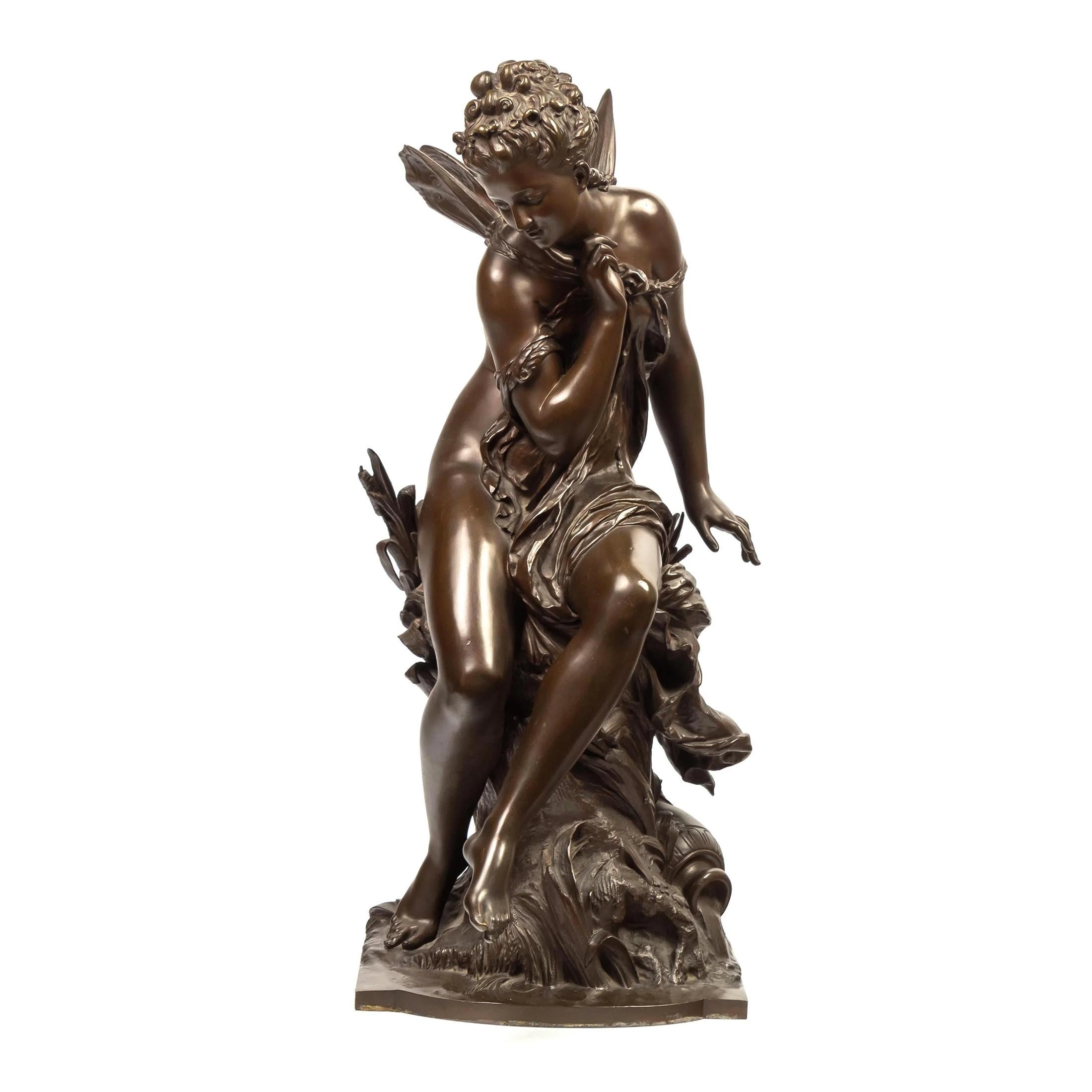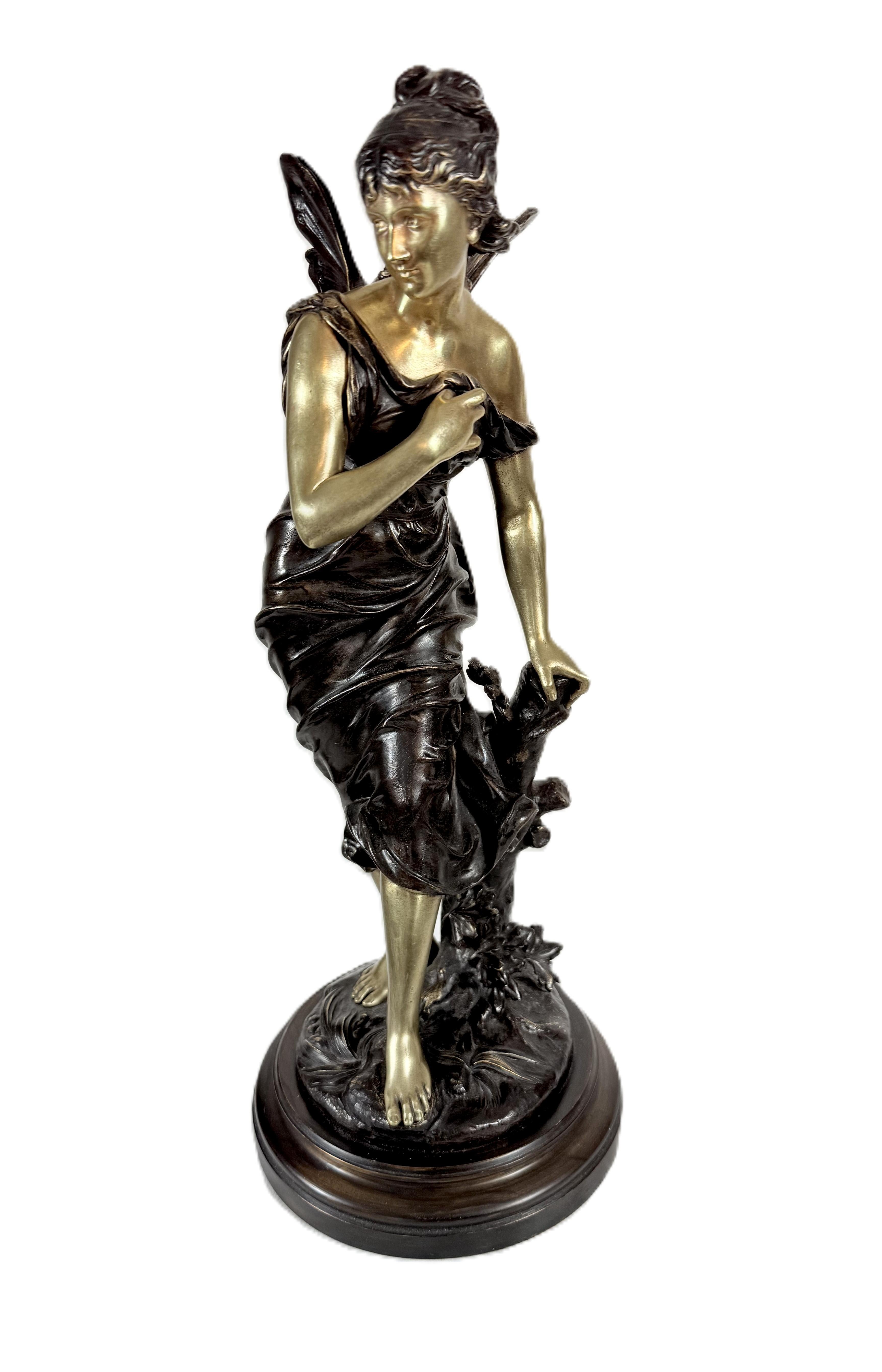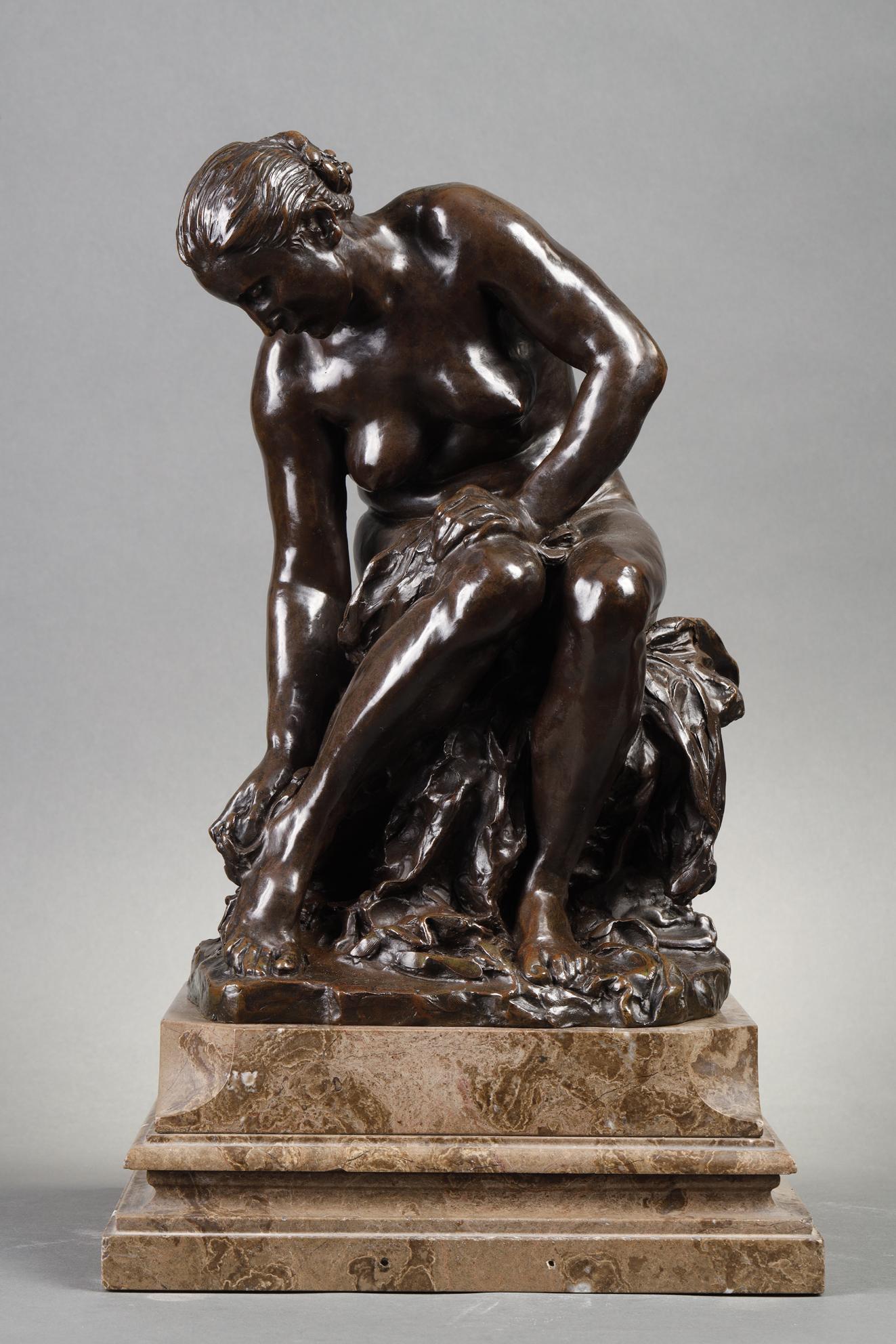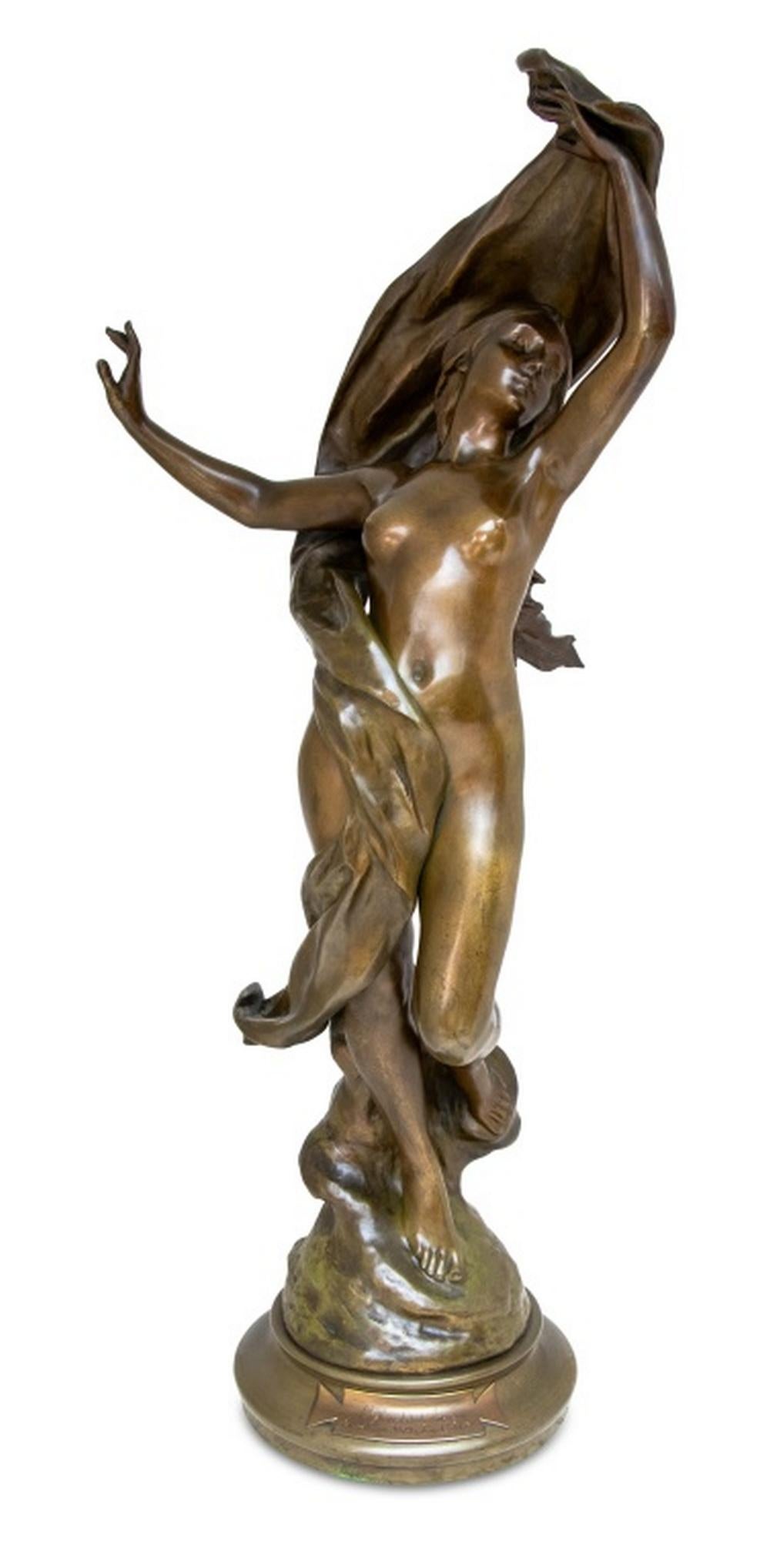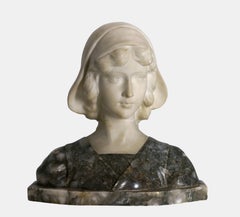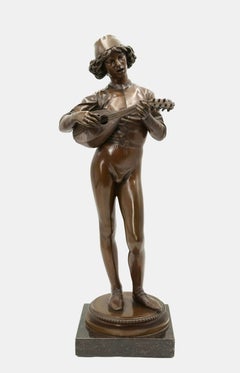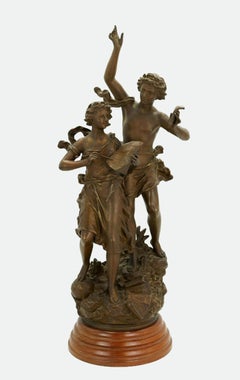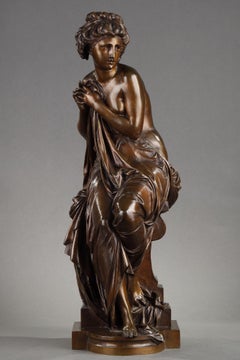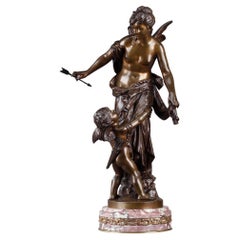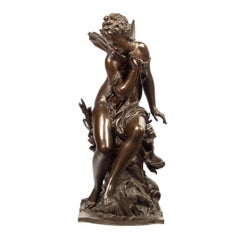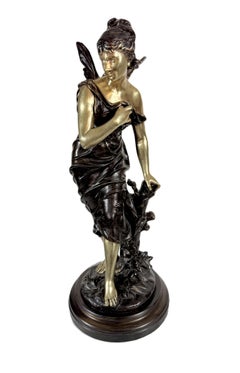Items Similar to Psyche / - Fulfilled longing -
Want more images or videos?
Request additional images or videos from the seller
1 of 11
Jan Jozef JaquetPsyche / - Fulfilled longing -1847
1847
$1,450.70
$1,813.3820% Off
£1,063.33
£1,329.1620% Off
€1,200
€1,50020% Off
CA$1,995.29
CA$2,494.1120% Off
A$2,172.91
A$2,716.1420% Off
CHF 1,141.74
CHF 1,427.1720% Off
MX$26,543.73
MX$33,179.6620% Off
NOK 14,181.03
NOK 17,726.2820% Off
SEK 13,410.07
SEK 16,762.5920% Off
DKK 9,136.78
DKK 11,420.9820% Off
About the Item
Jan Jozef Jaquet (1822 Antwerp - 1898 Brussels), Psyche, 1847. Black-brown and brown patinated bronze on a cast base. 30 cm (height) x 22 cm (width) x 12 cm (depth), weight 5 kg. Verso with J.[an] J.[ozef] JAQUET.” Inscribed, dated “1847” with the foundry mark “Cormann & Cie Bruxelles”.
- somewhat stained due to patina, very occasionally minimally rubbed, overall in excellent condition for its age
- Fulfilled longing -
Jan Jozef Jaquet masterfully expands the subject of the bust portrait. Classically, the bust is designed for a frontal view, which is predetermined by the horizontal shoulder line alone. The front view is also essential in Jaquet's bust, but a butterfly has settled on Psyche's shoulder and she is turning towards it, which also invites us to look at her from the side. If we follow this invitation, the butterfly unfolds to us in all its splendor, together with the beautiful face of the youthful Psyche. Her beauty had once aroused the envy of Venus and enchanted her son Armor, who finally succeeded in elevating Psyche to the heaven of the gods. Psyche gave birth to the beautiful daughter voluptas.
The mythical tale has a deeper meaning. In ancient Greek, 'psyche' means 'soul', so that the marriage of Armor and Psyche is also a marriage of the soul with the divine. In addition to 'soul', 'psyche' is also the term for 'butterfly', which is why, particularly in the later 18th century, the soul floating away after human death was depicted as a butterfly.
Psyche is watching the butterfly, which symbolizes herself, but at the same time she has her eyes devotedly closed and is filled with an inner soulfulness. At the same time, her face shows antique features: an elongated nose developing from the curve of the eyebrows, full lips and even eyes. Bringing the bust to life by depicting a specific situation is at the same time a revival of antique sculpture, which later earned Jaquet a professorship for sculpture after antiquity at the Brussels Academy of Fine Arts.
Corresponding to the sleep into which Venus had put Psyche, Psyche is adorned by a masterfully formed nightshade whose closed flowers begin to open, illustrating the blossoming of the soul in union with the divine.
In 1863, Jaquet was appointed professor at the Brussels Academy of Fine Arts, where Charles Samuel was one of his students. One of his most prestigious commissions was his artistic work for the Brussels Stock Exchange building designed by Léon-Pierre Suys, in whose sculptural decoration the young Auguste Rodin also collaborated. The two lions on the pedestals of the grand staircase are by Jaquet's hand.
About the artist
Jan Jozef Jaquet studied sculpture under Guillaume Geefs at the Antwerp Academy of Arts and followed his teacher to the Brussels Academy of Arts in 1839. There he first lived with the German landscape painter Peter Ludwig Kühnen, with whom he remained friends for the rest of his life. Kühnen also took in Jaquet's younger brother Jacques (1828-1899), who also studied sculpture and later worked closely with his brother.
From 1842 Jan Jozef Jaquet worked in the workshop of Guillaume Geefs, but from the same year he began to exhibit his works at the Brussels Salon, which established his artistic success. He was continuously represented at the Brussels Salon until 1875. In 1851, he received his first major commission to execute in marble the plaster model of The Golden Age that he had presented at the Salon. Subsequently, he became an extremely sought-after artist. In all, he created more than 300 sculptures and reliefs, including several monumental memorials such as the equestrian statue of Balduin I (1868) in Mons and the Monument to National Independence (1869) in The Hague. His oeuvre also includes around 30 busts, many of which were cast in bronze.
GERMAN VERSION
Jan Jozef Jaquet (1822 Antwerpen - 1898 Brüssel), Psyche, 1847. Schwarzbraun und braun patinierte Bronze auf mitgegossenem Sockel. 30 cm (Höhe) x 22 cm (Breite) x 12 cm (Tiefe), Gewicht, 5 kg. Rückseitig mit J.[an] J.[ozef] JAQUET.“ Bezeichnet, auf „1847“datiert mit der Gießermarke „Cormann & Cie Bruxelles“ versehen.
- patinabedingt etwas fleckig, sehr vereinzelt minimal betrieben, insgesamt in einem altersgemäß ausgezeichneten Zustand
- Erfüllte Sehnsucht -
Jan Jozef Jaquet erweitert virtuos das Sujet des Büstenporträt. Klassischerweise ist die Büste auf die Vorderansicht hin angelegt, was allein schon durch die horizontale Schulterlinie vorbestimmt wird. Auch bei Jaquets Büste ist die Vorderansicht wesentlich, auf der Schulter von Psyche hat sich jedoch ein Schmetterling niedergelassen, dem sie sich zuwendet, was uns ebenfalls zur seitlichen Betrachtung einlädt. Folgen wird dieser Einladung entfaltet sich auch uns der Schmetterling in seiner ganzen Pracht, zusammen mit dem schönen Antlitz der jugendlichen Psyche. Ihre Schönheit hatte einst den Neid von Venus heraufbeschworen und ihren Sohn Armor bezaubert, der schließlich erwirkte, dass Psyche in den Götterhimmel erhoben wurde. Zusammen zeugten die wunderschöne Tochter Volputas.
Die mythische Erzählung birgt einen tieferen Sinn. ‚Psyche‘ bedeutet auf Altgriechisch ‚Seele‘, so dass die Vermählung von Armor und Psyche zugleich eine Vermählung der Seele mit dem Göttlichen ist. Neben ‚Seele‘ ist ‚Psyche‘ zugleich die Bezeichnung für ‚Schmetterling‘, weshalb insbesondere im späteren 18. Jahrhundert die nach dem Tod des Menschen entschwebende Seele als Schmetterling dargestellt wurde.
Psyche gewahrt den Schmetterling, der symbolisch für sie selbst einsteht, sie hat die Augen aber zugleich hingebungsvoll geschlossen und ist von einer inneren Beseeltheit erfüllt. Dabei weist ihr Antlitz antikisierende Züge auf: eine gelängte, sich aus dem Schwung der Augenbrauen entwickelnde Nase, volle Lippen und ebenmäßige Augen. Die Verlebendigung der Büste durch die Darstellung einer bestimmten Situation ist zugleich eine Verlebendigung der antiken Skulptur, was Jaquet später an der Brüsseler Kunstakademie eine Professur für die Skulptur nach der Antik einbrachte.
Entsprechend dem dornröschenähnlichen Schlaf, in den Venus Psyche versetzt hatte, wird Psyche von einem meisterhaft ausgeformten Nachtschattengewächs geziert, dessen geschlossenen Blüten sich zu öffnen beginnen, was wiederum das seelische Aufblühen in der Vereinigung mit dem Göttlichen veranschaulicht.
zum Künstler
Jan Jozef Jaquet studierte an der Kunstakademie Antwerpen bei Guillaume Geefs Bildhauerei und folgte seinem Lehrer 1839 an die Kunstakademie Brüssel. Dort wohnte er zunächst bei dem deutschen Landschaftsmaler Peter Ludwig Kühnen, mit dem er lebenslang freundschaftlich verbunden blieb. Kühnen beherbergte auch Jaquets jüngeren Bruder Jacques (1828-1899), der ebenfalls Bildhauerei studierte und später eng mit seinem Bruder zusammenarbeitete.
Ab 1842 war Jan Jozef Jaquet in der Werkstatt von Guillaume Geefs tätig, begann aber ab demselben Jahr seine Werke im Brüsseler Salon auszustellen, was seinen künstlerischen Erfolg begründete. Bis 1875 war er durchgehend im Brüsseler Salon vertreten. 1851 erhielt er den ersten größeren Auftrag, sein im Salon präsentiertes Gipsmodell „Das goldene Zeitalter“ in Marmor auszuführen. In der Nachfolge wurde er zu einem äußerst gefragten Künstler. Insgesamt schuf er über 300 Skulpturen und Reliefs, darunter auch mehrere Monumentaldenkmäler wie die Reiterstatue Balduin I (1868) in Mons oder das Denkmal der nationalen Unabhängigkeit (1869) in Den Haag. Sein Oeuvre umfasst auch etwa 30 Büsten, von denen zahlreiche in Bronze gegossen wurden.
1863 wurde Jaquet als Professor an die Brüsseler Kunstakademie berufen, wo Charles Samuel zu seinen Schülern gehörte. Einer der renommiertesten Aufträge war seine künstlerische Tätigkeit für das von Léon-Pierre Suys entworfene Brüsseler Börsengebäude, an dessen skulpturaler Ausstattung auch der junge Auguste Rodin mitwirkte. Von Jaquets Hand sind die beiden Löwen auf den Postamenten der Freitreppe.

About the Seller
5.0
Vetted Professional Seller
Every seller passes strict standards for authenticity and reliability
Established in 2014
1stDibs seller since 2023
21 sales on 1stDibs
- ShippingRetrieving quote...Shipping from: Berlin, Germany
- Return Policy
Authenticity Guarantee
In the unlikely event there’s an issue with an item’s authenticity, contact us within 1 year for a full refund. DetailsMoney-Back Guarantee
If your item is not as described, is damaged in transit, or does not arrive, contact us within 7 days for a full refund. Details24-Hour Cancellation
You have a 24-hour grace period in which to reconsider your purchase, with no questions asked.Vetted Professional Sellers
Our world-class sellers must adhere to strict standards for service and quality, maintaining the integrity of our listings.Price-Match Guarantee
If you find that a seller listed the same item for a lower price elsewhere, we’ll match it.Trusted Global Delivery
Our best-in-class carrier network provides specialized shipping options worldwide, including custom delivery.More From This Seller
View AllBust of a young woman / - Beauty of youth -
Located in Berlin, DE
Anonymous, Bust of a young woman, c. 1900, artificial marble and gray onyx marble. 37 cm (height) x 37 cm (width) x 22 cm (depth), weight 17.2 kg. Signed “GURRINI” on the reverse.
-...
Category
Early 1900s Realist Figurative Sculptures
Materials
Marble
$918 Sale Price
20% Off
Florentine singer / - The Renaissance of the Renaissance -
By Paul Dubois
Located in Berlin, DE
Paul Dubois (1829 Nogent-sur-Seine - 1905 Paris), Florentine singer, 1865. Light brown patinated bronze with cast round plinth mounted on a square marble base (3.5 cm high). Total height 53 cm. Bronze dimensions: 49.5 cm (height) x 20 cm (length) x 10 cm (width), weight 5.6 kg. Inscribed on the plinth "P.[aul] DUBOIS", dated "1865", with the foundry's mark "F. BARBEDIENNE FONDEUR" and the signet "REDUCTION MECANIQUE A. COLLAS".
- Patina very occasionally darkened, lute with loss of one tuning peg, otherwise in excellent condition.
- The renaissance of the Renaissance -
The bronze is a precisely executed and masterfully cast contemporary reduction of Paul Dubois 155 cm tall masterpiece "Florentine Singer", which is exhibited in the Musée d'Orsay and for which the artist was awarded the Medal of Honor at the Paris Salon in 1865. The work acted as a beacon, and was followed by a plethora of depictions of juveniles.
Inspired by Donatello and Luca della Robbia, but also by painters such as Piero della Francesca, Benozzo Gozzoli, and Pinturicchio, the "Florentine Singer" is not an epigonal work that pays homage to a vanished era, but a successful attempt to draw vitality from the art of the past and thus give it new life.
The effect of vitality is the core of Italian Renaissance art theory. In order to fulfill itself as art, art had to appear like nature. This naturalism also characterizes the "Florentine Singer". The young man appears to have been taken from life, which is reinforced by the momentary nature of his action. He has just struck a now fading chord. In addition, the natural appearance is enhanced by the detailed shaping of the figurative details, such as the laces with the slightly curved leather of the shoes, the belt buckle, or the ornamentation on the body of the lute. Even the fingernails are clearly defined. Unlike the Renaissance, however, the effect of liveliness here is not based on the "discovery" of nature and the human body, but primarily on the rediscovery of the art of the Quattrocento. The liveliness of the artwork is therefore at the same time a revitalization of this art, so that we can speak of a Renaissance of the Renaissance, just as the Pre-Raphaelites in England at the same time transferred the Quattrocento to contemporary art.
Dubois takes on the most difficult of all subjects, the depiction of singing through silent sculpture. He was preceded in this by Luca della Robbia and Donatello with their pulpits of singers created in the 1430s in the Museo dell'Opera del Duomo in Florence. Compared to these works, the physiognomy of Dubois singer is far less animated, yet he also depicts singing in a convincing manner. He uses the whole body. He takes the ancient contrapposto, which was essential to Renaissance sculpture, and transforms the standing leg-playing posture into a late medieval S-swing, giving the body an elegant beauty and at the same time setting it in melodic motion. In the equally elegant finger position, the music is expressed in a much more literal way with the beating of the lute. Finally, the musicality of the sculpture culminates in the face with the mouth open to sing.
Through the act of singing, which is a great challenge to the artistic will to depict perfect beauty, the gracefulness of the classical face is not diminished, but enhanced. Starting from the face with the singing mouth and the gaze absorbed by the sounds, the inner vitality spreads, giving the bronze sculpture an intense aura, enhanced by the music. Dubois transfers the beauty of the Renaissance to the musical, sublimating the visible sculpture to the invisible of music.
He took up the challenge of transcending the Renaissance with the Renaissance, thus responding to the Querelle des Anciens et des Modernes, which arose at the end of the 17th century around the French Academy and remained virulent into the 19th century, in which antiquity was regarded either as an unattainable ideal or as a standard to be surpassed. With his work, Dubois proved that the Renaissance, which had championed the art of the ancients, could lead to a new renaissance of art.
About the artist
Paul Dubois' great-uncle was the famous French Baroque sculptor Jean-Baptiste Pigalle, in whose footsteps the talented great-nephew followed. When he debuted at the Paris Salon in 1858, he signed his work "Dubois-Pigalle". At his father's request, however, he first studied law before devoting himself to sculpture under the tutelage of François Christophe Armand Toussaint in 1856 and entering the École des Beaux-Arts in 1858. From 1859 to 1863, he lived in Rome and traveled to Naples and Florence. Inspired by Florentine art of the quattrocento, Dubois initiated a school-forming neo-Florentine style that combined the elegantly simple forms of youthful grace with a precise wealth of detail.Two purchases by the French state (“envois de Rome”) were made during his stay in Rome, which brought him recognition in Paris. After his return there, he quickly became an internationally sought-after artist.
Dubois was also active as a creator of monuments. His most famous work is the equestrian statue of Joan of Arc (1896) on the forecourt of Reims Cathedral. He was also a sought-after portraitist who produced around 50 busts and - Dubois was also a passionate painter - around 100 portraits in oil.
From 1873 to 1878 he was curator of the Museum du Luxembourg, in 1876 he became a member of the Institut de France and from 1878 to 1905 he was director of the École des Beaux-Arts.
In 1865, Dubois was awarded the Paris Salon Medal of Honor for his “Florentine Singer”. In 1867 he became Chevalier, in 1874 Officier, in 1886 Commandeur of the Légion d'honneur, which awarded Dubois the Grande Croix in 1896.
Selected Bibliography
Stole, Elmar: Paul Dubois. In: Saur. Allgemeines Künstlerlexikon, vol. 30, Munich - Leipzig 2001, pp. 677-678.
GERMAN VERSION
Paul Dubois (1829 Nogent-sur-Seine - 1905 Paris), Florentinischer Sänger, 1865. Hellbraun patinierte Bronze mit gegossener runder Plinthe auf quadratischem Marmorsockel montiert (3,5 cm Höhe). Gesamthöhe 53 cm. Maße der Bronze: 49,5 cm (Höhe) x 20 cm (Länge) x 10 cm (Breite), Gewicht 5,6 kg. Auf der Plinthe mit „P.[aul] DUBOIS“ bezeichnet, auf „1865“ datiert, mit dem Gießereistempel „F. BARBEDIENNE FONDEUR“ und dem Signet „REDUCTION MECANIQUE A. COLLAS“ versehen.
- Patina sehr vereinzelt nachgedunkelt, Laute mit Verlust eines Stimmwirbels, ansonsten ausgezeichnet erhalten.
- Die Renaissance...
Category
1860s Realist Figurative Sculptures
Materials
Bronze
$4,352 Sale Price
20% Off
Bust of a young woman / - The Opulence of Beauty -
Located in Berlin, DE
Anton Nelson (i.e. Antoine Joseph van den Kerckhoven) (1849 Brussels - after 1910 ibid.), Bust of a young woman, c. 1890. Patinated bronze on cast base, 30 cm (total height) x 20 cm ...
Category
1890s Art Nouveau Figurative Sculptures
Materials
Bronze
Allegory of Progress / - The Driving Force of Inspiration -
Located in Berlin, DE
Ernest Rancoulet (1842-1918), Allegory of Progress, around 1890. Bronze-plated metal cast with cast terrain plinth mounted on a wooden base (6 cm high). 64.5 cm (total height) x 28 c...
Category
1890s Realist Figurative Sculptures
Materials
Metal
Pecheur / - Full of anticipation -
Located in Berlin, DE
Adolphe Jean Lavergne (1863-1928), Pecheur, c. 1900. Brown patinated bronze with rectangular cast plinth on a green marble base (3 cm high), total height with hinge 37 cm, width 9 cm, depth 8 cm, weight 2.9 kg, signed “Lavergne” on the plinth.
- Base with old drilling and a few oxidized areas, patina occasionally rubbed, somewhat stained in the folds.
- Full of anticipation -
This bronze is the larger, highly detailed version of the fisherman that made Parisian artist Adolphe Jean Lavergne famous. In preparation for fishing, the boy prepares his rod before heading out to sea. The attachment of the iron ring and the rope behind him suggest a quay wall and a boat moored there. However, the depiction is entirely focused on the actual action of the young fisherman: With equal skill and concentration, he bends a hook to connect it to the fishing line. The contrast with his casual clothing, the loose-fitting trousers, the open shirt with its "wild" folds, and, last but not least, the sun hat boldly perched on his neck, reinforces the impression of the attentive care with which he goes about his work. His gaze makes him appear absorbed, as if he has forgotten the world around him and yet he is visibly filled with anticipation of fishing.
GERMAN VERSION
Adolphe Jean Lavergne (1863-1928), Pecheur, um 1890. Braun patinierte Bronze mit rechteckiger gegossener Plinthe auf grünem Marmorsockel (3 cm Höhe), Gesamthöhe mit Angel 37 cm, Breite 9 cm, Tiefe 8 cm, Gewicht 2,9 kg, auf der Plinthe mit „Lavergne“ signiert.
- Sockel mit alter Bohrung und wenigen oxidierten Stellen, Patina mitunter berieben, in den Falten vereinzelt etwas fleckig.
- Voller Vorfreude -
Die Bronzefigur ist die größere äußerst detaillierte Ausführung des Fischers, mit dem der Pariser Künstler Adolphe Jean Lavergne bekannt geworden ist. In Vorbereitung auf das Fischen präpariert der Junge die Angel...
Category
1890s Realist Figurative Sculptures
Materials
Bronze
$696 Sale Price
20% Off
Juggler / - Artistic naturalness -
Located in Berlin, DE
Claire Jeanne Robertine Colinet (1880 Brussels - 1950 Asnières-sur-Seine), Juggler, around 1920. Brownish patinated bronze with gilded balls on a round, multi-profiled stone base (10...
Category
1920s Art Deco Nude Sculptures
Materials
Bronze
You May Also Like
Susanna
By Albert-Ernest Carrier-Belleuse
Located in PARIS, FR
Susanna
by Albert-Ernest Carrier-Belleuse (1824-1887)
Bronze sculpture with nuanced brown patina
signed to the side " A. Carrier "
old period cast
France
circa 1860
height 62 cm
...
Category
1860s French School Figurative Sculptures
Materials
Bronze
Sculpture "Psyche and Love" Signed by Jean Bulio
By Jean Bulio
Located in Paris, FR
Statue in bronze with medal patina "Psyche and Cupid" realized by Jean BULIO. It represents Psyche, recognizable by her butterfly wingst. Her chest is bare and she is holding an arro...
Category
Antique 1850s French Figurative Sculptures
Materials
Bronze
Mathurin Moreau Bronze Allegorical Sculpture
By Mathurin Moreau
Located in New York, NY
MATHURIN MOREAU
French, (1822-1912)
‘La Libellule’
signed ‘Moreau Mathurin’
27 1/2 in. 11 1/2 in. x 15 in.
Notes: A fine quality Art Nouveau alleg...
Category
19th Century Figurative Sculptures
Materials
Bronze
Eutrope Bouret (1833-1906) Psyché
By Eutrope Bouret
Located in Berlin, DE
Eutrope Bouret Bronze
Spyche
Eutrope Bouret (French, 1833-1906)
Late 19th century.
Signed on the base
Bouret (French, 1833–1906) was an important 19...
Category
19th Century Jugendstil Figurative Sculptures
Materials
Bronze
Suzanne
By Aimé-Jules Dalou
Located in PARIS, FR
Bathing woman drying her right foot
also known as "Suzanne"
by Aimé-Jules DALOU (1838-1902)
A bronze sculpture with a nuanced dark brown patina
Signed on the base " Dalou "
A very...
Category
Early 20th Century French School Figurative Sculptures
Materials
Bronze
Henri Godet "L'Aurore" Patinated Bronze Sculpture
By Henri Godet
Located in Astoria, NY
Henri Godet (French, 1863-1937) "La Reveil de L'Aurore" [The Awakening of Dawn] Patinated Bronze Sculpture, early 20th century, on a circular base with applied plaque "La Reveil de L...
Category
Early 20th Century Figurative Sculptures
Materials
Bronze
